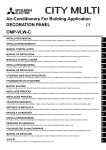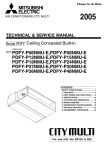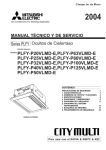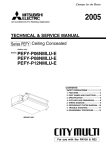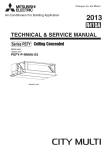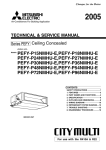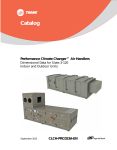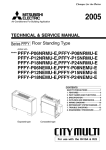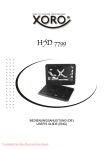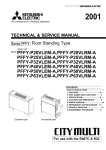Download Mitsubishi Electric PLFY-P15NLMU-E Service manual
Transcript
2005
Air-Conditioners For Building Application
TECHNICAL & SERVICE MANUAL
Series PLFY Ceiling Cassettes
<Indoor unit>
Models
PLFY-P06NLMU-E
PLFY-P08NLMU-E
PLFY-P12NLMU-E
PLFY-P15NLMU-E
PLFY-P18NLMU-E
CONTENTS
SAFETY PRECAUTIONS ·························1
1. FEATURES ···········································3
2. PART NAMES AND FUNCTIONS ········4
3. SPECIFICATION ···································6
4. OUTLINES AND DIMENSIONS············8
5. WIRING DIAGRAM ·····························10
6. REFRIGERANT SYSTEM DIAGRAM ····11
7. TROUBLE SHOOTING ·······················12
8. DISASSEMBLY PROCEDURE ···········17
INDOOR UNIT
For use with the R410A & R22
SAFETY PRECAUTIONS
1.
Before installation and electric work
s Before installing the unit, make sure you read all the
“Safety precautions”.
s The “Safety precautions” provide very important
points regarding safety. Make sure you follow them.
•
•
•
s This equipment may cause the adverse effect on the
same supply system.
s Please report to or take consent by the supply authority before connection to the system.
•
•
Symbols used in the text
Warning:
Describes precautions that should be observed to prevent danger
of injury or death to the user.
Caution:
Describes precautions that should be observed to prevent damage
to the unit.
Symbols used in the illustrations
•
•
•
: Indicates an action that must be avoided.
: Indicates that important instructions must be followed.
: Indicates a part which must be grounded.
•
: Indicates that caution should be taken with rotating parts. (This
symbol is displayed on the main unit label.) <Color: Yellow>
: Beware of electric shock (This symbol is displayed on the main
unit label.) <Color: Yellow>
Warning:
•
Carefully read the labels affixed to the main unit.
Warning:
•
•
•
•
•
1
Ask the dealer or an authorized technician to install the air conditioner.
- Improper installation by the user may result in water leakage, electric shock, or fire.
Install the air unit at a place that can withstand its weight.
- Inadequate strength may cause the unit to fall down, resulting in
injuries.
Use the specified cables for wiring. Make the connections securely so that the outside force of the cable is not applied to the
terminals.
- Inadequate connection and fastening may generate heat and cause
a fire.
Prepare for typhoons and other strong winds and earthquakes
and install the unit at the specified place.
- Improper installation may cause the unit to topple and result in
injury.
Always use an air cleaner, humidifier, electric heater, and other
accessories specified by Mitsubishi Electric.
- Ask an authorized technician to install the accessories. Improper
installation by the user may result in water leakage, electric shock,
or fire.
•
•
•
•
Never repair the unit. If the air conditioner must be repaired,
consult the dealer.
- If the unit is repaired improperly, water leakage, electric shock, or
fire may result.
Do not touch the heat exchanger fins.
- Improper handling may result in injury.
If refrigerant gas leaks during installation work, ventilate the
room.
- If the refrigerant gas comes into contact with a flame, poisonous
gases will be released.
Install the air conditioner according to this Installation Manual.
- If the unit is installed improperly, water leakage, electric shock, or
fire may result.
Have all electric work done by a licensed electrician according
to “Electric Facility Engineering Standard” and “Interior Wire
Regulations”and the instructions given in this manual and always use a special circuit.
- If the power source capacity is inadequate or electric work is performed improperly, electric shock and fire may result.
Keep the electric parts away from water (washing water etc.).
- It might result in electric shock, catching fire or smoke.
Securely install the cover of control box and the panel.
- If the cover and panel are not installed properly,dust or water may
enter the outdoor unit and fire or electric shock may result.
When installing and moving the air conditioner to another site,
do not charge the it with a refrigerant different from the refrigerant specified on the unit.
- If a different refrigerant or air is mixed with the original refrigerant,
the refrigerant cycle may malfunction and the unit may be damaged.
If the air conditioner is installed in a small room, measures
must be taken to prevent the refrigerant concentration from
exceeding the safety limit even if the refrigerant should leak.
- Consult the dealer regarding the appropriate measures to prevent the safety limit from being exceeded. Should the refrigerant
leak and cause the safety limit to be exceeded, hazards due to
lack of oxygen in the room could result.
When moving and reinstalling the air conditioner, consult the
dealer or an authorized technician.
- If the air conditioner is installed improperly, water leakage, electric shock, or fire may result.
After completing installation work, make sure that refrigerant
gas is not leaking.
- If the refrigerant gas leaks and is exposed to a fan heater, stove,
oven, or other heat source, it may generate noxious gases.
Do not reconstruct or change the settings of the protection
devices.
- If the pressure switch, thermal switch, or other protection device
is shorted and operated forcibly, or parts other than those specified
by Mitsubishi Electric are used, fire or explosion may result.
To dispose of this product, consult your dealer.
Do not use a leak detection additive.
2.
Warning:
•
Note the following when building a heater in the air
conditioning system.
- Leave enough space between units for proper ventilation so that
the indoor unit temperature does not exceed 40˚C when
windless.
- Keep the heater clean, and take appropriate measures so that
the indoor unit does not suck in the dust particles that
accumulate on the heater.
- Use the optional heater cable (PAC-YU24HT) to perform an
interlocked operation with indoor units.
- Do not build a heater inside the indoor unit.
Caution:
•
•
Recommended circuit
Wiring diagram
88H
FS1
H1
88H
FS2
FS1
H2
R
1-phase power
supply
S
208V, 230V/60Hz
R
S
•
FS2
26H
•
88H
Control board
CN24
•
FS1, 2 ----- Thermal fuse
H1, H2 ----- Heater
26H --------- Overheat protection
thermostat
Precautions for devices that use
R410A refrigerant
•
88H --------- Electromagnetic contactor
•
•
•
•
Do not use the existing refrigerant piping.
- The old refrigerant and refrigerator oil in the existing piping contains a large amount of chlorine which may cause the refrigerator
oil of the new unit to deteriorate.
Use refrigerant piping made of C1220 (Cu-DHP) phosphorus
deoxidized copper as specified in the *JIS H3300 “Copper and
copper alloy seamless pipes and tubes”. In addition, be sure
that the inner and outer surfaces of the pipes are clean and
free of hazardous sulphur, oxides, dust/dirt, shaving particles,
oils, moisture, or any other contaminant.
- Contaminants on the inside of the refrigerant piping may cause
the refrigerant residual oil to deteriorate.
*JIS: Japanese Industrial Standard
Store the piping to be used during installation indoors and keep
both ends of the piping sealed until just before brazing. (Store
elbows and other joints in a plastic bag.)
- If dust, dirt, or water enters the refrigerant cycle, deterioration of
the oil and compressor trouble may result.
Use ester oil, ether oil or alkylbenzene (small amount) as the
refrigerator oil to coat flares and flange connections.
- The refrigerator oil will degrade if it is mixed with a large amount of
mineral oil.
Use liquid refrigerant to fill the system.
- If gas refrigerant is used to seal the system, the composition of
the refrigerant in the cylinder will change and performance may
drop.
Do not use a refrigerant other than R410A.
- If another refrigerant (R22, etc.) is used, the chlorine in the refrigerant may cause the refrigerator oil to deteriorate.
Use a vacuum pump with a reverse flow check valve.
- The vacuum pump oil may flow back into the refrigerant cycle and
cause the refrigerator oil to deteriorate.
Do not use the following tools that are used with conventional
refrigerants.
(Gauge manifold, charge hose, gas leak detector, reverse flow
check valve, refrigerant charge base, vacuum gauge, refrigerant recovery equipment)
- If the conventional refrigerant and refrigerator oil are mixed in the
R410A , the refrigerant may deteriorated.
- If water is mixed in the R410A , the refrigerator oil may deteriorate.
- Since R410A does not contain any chlorine, gas leak detectors
for conventional refrigerants will not react to it.
Do not use a charging cylinder.
- Using a charging cylinder may cause the refrigerant to deteriorate.
Be especially careful when managing the tools.
- If dust, dirt, or water gets in the refrigerant cycle, the refrigerant
may deteriorate.
2
1
FEATURES
Series PLFY Ceiling Cassettes
Indoor unit
Models
3
Cooling capacity/Heating capacity
kW
BTU / h
PLFY-P06NLMU-E
1.8 / 2.0
6000 / 6700
PLFY-P08NLMU-E
2.3 / 2.6
8000 / 9000
PLFY-P12NLMU-E
3.5 / 4.0
12000 / 13500
PLFY-P15NLMU-E
4.4 / 5.0
15000 / 17000
PLFY-P18NLMU-E
5.3 / 5.9
18000 / 20000
2
PART NAMES AND FUNCTIONS
● Indoor (Main) Unit
Autovane
Disperses the airflow up and down and
adjusts the angle of the airflow.
Long-life filter
Removes the sucked-in dust and dirt.
Since the long-life filter is used as an air
filter, it should be cleaned at the beginning of air-cooling and heating seasons.
(During seasons with large amounts of
dust and dirt, more frequent cleaning are
recommended.)
Air inlet
Sucks the ambient air in.
● Remote controller
[PAR-21MAA]
● Once the controls are set, the same operation mode can
be repeated by simply pressing the ON/OFF button.
[Operation buttons]
1
TEMP.
ON/OFF
2
MENU
3
BACK
PAR-21MAA
MONITOR/SET
ON/OFF
FILTER
DAY
CLOCK
CHECK TEST
OPERATION
B
7
A
0
CLEAR
C
D
1 [Set Temperature] Button
2 [Timer Menu] Button
[Monitor/Set] Button
3 [Mode] Button
[Return] Button
4 [Timer On/Off] Button
[Set Day] Button
4 5 68
5 [Louver] Button
[Operation] Button
6 [Fan Speed] Button
7 [Airflow Up/Down] Button
8 [Ventilation] Button
[Operation] Button
9 [Check/Clear] Button
9
0 [Test run] Button
A [Filter] Button
[
] Button
B [ON/OFF] Button
C Position of built-in room temperature
D [Set Time] Button
• Never expose the remote controller to direct sunlight. Doing so can result in the erroneous measurement of room temperature.
• Never place any obstacle around the lower right-hand section of the remote controller. Doing so can
result in the erroneous measurement of room temperature.
4
[Display]
A
CENTRALLY CONTROLLED
E
ON
ERROR CODE
C
NOT AVAILABLE
TEMP.
G
5
C
C
STAND BY
DEFROST
A
B
C
D
E
F
G
H
I
J
K
L
M
N
O
P
1Hr.
OFF
CLOCK
CHECK
B
P
Current time/Timer
Centralized control
Timer OFF
Timer indicator
Operation mode: COOL, DRY,
“Locked” indicator
Set temperature
Power ON
Louver
Ventilation
Filter sign
Set effective for 1 hr.
Sensor position
Room temperature
Airflow
Fan speed
FILTER
CHECK MODE
TEST RUN
FUNCTION
ON/OFF
O L I N HQ J
AUTO,
FAN,
D
HEAT
M
F
K
3
SPECIFICATION
3-1. Specification
PLFY-P-NMLU-E
Item
Power sourse
Capacity
*1
Model
Cooling
Heating
Height
Dimension
*4
Width
Depth
Net weight
FAN
Airflow rate
(Low-Middle-High)
External static
pressure
Noise level
(Low-Middle-High) *2
Filter
kW
BTU/h
kW
BTU/h
mm
in
mm
in
mm
in
kg
lb
m3/min
cfm
208V
Pa
230V
208V
dB(A)
230V
PLFY-P06NLMU-E
PLFY-P08NLMU-E
PLFY-P12NLMU-E PLFY-P15NLMU-E
208/230V, 60Hz
1.8
2.3
3.5
4.4
6000
8000
12000
15000
2.0
2.6
4.0
5.0
6700
9000
13500
17000
290 (20)
11-7/16 (13/16)
776 (1080)
30-9/16 (42-17/32)
634 (710)
24-31/32 (27-31/32)
23 (6.5)
24 (6.5)
51 (15)
53 (15)
6.5-8.0-9.5
6.5-8.0-9.5
6.5-8.0-9.5
7.0-8.5-10.5
230-282-335
230-282-335
230-282-335
247-300-371
27-30-33
27-30-33
27-30-33
29-33-36
28-31-34
28-31-34
28-31-34
30-34-37
Standard filter
PLFY-P18NLMU-E
5.3
18000
5.9
20000
946 (1250)
37-1/4 (49-7/32)
27 (7.5)
60 (17)
9.0-11.0-12.5
318-388-441
31-34-37
32-35-38
Notes: *1 Cooling/Heating capacity indicates the maximum value at operation under the following condition.
Outdoor: 35 ˚C [95 ˚F ] DB
Cooling: Indoor: 26.7 ˚C [80 ˚F] DB/19.4 ˚C [67 ˚F] WB
Heating: Indoor: 21.1 ˚C [70 ˚F] DB
Outdoor: 8.3 ˚C [47 ˚F] DB/6.1˚C [ 43 ˚F] WB
*2 The operating noise is the data that was obtained in an anechoic room.
*4 The figure in ( ) indicates Panel's.
6
3-2. Electrical parts specifications
Model
Parts
Symbol PLFY-P06NLMU-E
PLFY-P08NLMU-E
PLFY-P12NLMU-E PLFY-P15NLMU-E
PLFY-P18NLMU-E
name
Tranrsformer
T
Room
temperature
TH21
thermistor
Liquid pipe
thermistor
Gas pipe
thermistor
TH22
TH23
(Primary) 220-240V 50Hz, 220-230V 60Hz (Secondry) 23.2V 1.1A
Resistance 0¡C[32¡F]/15k½, 10¡C[50¡F]/9.6k½, 20¡C[68¡F]/6.3k½,25¡C[77¡F]/5.4k½,
30¡C[86¡F]/4.3k½, 40¡C[104¡F]/3.0k½
Resistance 0¡C[32¡F]/15k½, 10¡C[50¡F]/9.6k½, 20¡C[68¡F]/6.3k½,25¡C[77¡F]/5.4k½,
30¡C[86¡F]/4.3k½, 40¡C[104¡F]/3.0k½
Resistance 0¡C[32¡F]/15k½, 10¡C[50¡F]/9.6k½, 20¡C[68¡F]/6.3k½,25¡C[77¡F]/5.4k½,
30¡C[86¡F]/4.3k½, 40¡C[104¡F]/3.0k½
Fuse
(Indoor
F901
250V 6.3A
controller board)
Fan motor
(with Inner-
MF1
thermostat)
capacitor
Vane motor
Drain-up
mechanism
Drain sensor
C1
MV
DP
UEM6Q-21SA3P
OFF 145±8¡C[293±46¡F]
-
ON 88±15¡C[190±59¡F]
(Fan motor)
Fan motor
OUTPUT 20W
UEM6Q-11SA3P
Innerthermostat
6-pole
6-pole OUTPUT 15W
1.3µF x 440V
1.5µF x 440V
DC12V Stepping motor
INPUT 6.4/5.5W
3
400cm /min
DS
Resistance 0¡C[32¡F]/6.0k½, 10¡C[50¡F]/3.9k½, 20¡C[68¡F]/2.6k½,25¡C[77¡F]/2.2k½,
30¡C[86¡F]/1.8k½, 40¡C[104¡F]/1.3k½
DC12V Stepping motor drive port dimension
Linear
expansion valve
Power supply
terminal bed
7
1.7µF x 440V
LEV
ø 3.2 (0~2000pulse)
0~1800pulse <at R410A outdoor unit>
0~2000pulse <at the other outdoor unit>
TB2
Transmission
TB5
terminal bed
TB15
(L1,L2,G)
(M1,M2,S),(1,2)
330V 30A
300V 10A
108
(4-9/32)
222(8-3/4)
190(7-1/2)
4-ø2.9(1/8) Mounting hole
20(13/16)
Standard center panel
Model
A
B
C
PLFY-P06NLMU-E
PLFY-P08NLMU-E CMP-40VLW-B 1080(42-17/32) 1040(40-31/32) 776(30-9/16)
PLFY-P12NLMU-E
PLFY-P15NLMU-E
PLFY-P18NLMU-E CMP-63VLW-B 1250(49-7/32) 1210(47-21/32) 946(37-1/4)
E
388(15-9/32)
473(18-5/8)
824(32-15/32)
994(39-5/32)
E
221(8-23/32)
(2-25/32) (5-3/4)
507(19-31/32)
3 Drain hose
Terminal box
Drain hole
20(13/16)
1 ø12.7(1/2)
2 ø15.88(5/8)
ø12.7(1/2)
1
2
ø6.35(1/4)
ø9.52(3/8)
ø6.35(1/4)
Drain hose 32mm
(1-1/4inch)
<flexible joint >
(accessory)
3Drain hose
mm(in.)
Water filling port
670(26-13/32)
70(2-25/32)
634(24-31/32)
509(20-1/32)
497(19-19/32)
Air filter
146
(5-3/4)
574(22-5/8)(Suspension bolt pitch)
1Gas pipe <flare> 2Liquid pipe <flare>
1 :R410A outdoor unit
2 :R22 outdoor unit
20(13/16)
Terminal bed(Transmission)
68(2-11/16)
Suspension bolt hole
4-14x30(9/16x1-3/16) Slot
6-ø2.9(1/8) Mounting hole
Control box
D
A
B
217.5x2=435(8-19/32x2=17-5/32)
108
(4-9/32)
146
70
(1-29/32)
48
Fresh air intake 240x45(9-15/32x1-25/32) knock out hole
197(7-25/32)
240(9-15/32)
D(Suspension bolt pitch)
C
B(Opening dimension)
D(Suspension bolt pitch)
52(2-1/16)
670(26-13/32)(Opening dimension)
266(10-1/2)
Branch duct Fx110(4-11/32) knock out hole (both side)(Note:2)
216(8-17/32)
45
34(1-11/32)
110
(4-11/32)
159
(6-9/32)
Terminal bed(Power source)
(2-3/8)
60
(67(2-21/32))
583(22-31/32) Max
634(24-31/32)
45(1-25/32)
1 Gas pipe
2 Liquid pipe
68(2-11/16)
Note: 1.Use M10 screw for the Suspension bolt (field supply).
2.It is available to connect the branch duct on right and left side both.
3.On Model :18, you would use flare nut
packed with the Indoor Unit, when connecting
the Outdoor Unit for R22.
3
170 ± 5(6-23/32 ± 7/32)(Actual length)
300(11-13/16) or less
20(13/16)
122
(4-13/16)
190(7-1/2)
(78(3-3/32))
290(11-7/16)
(1-29/32)
48
574(22-5/8)(Suspension bolt pitch)
(1-25/32)
73 202(7-31/32)
(2-7/8)
710(27-31/32)
More than 350(13-25/32)
20(13/16)
4
OUTLINES AND DIMENSIONS
PLFY-P06·08·12·15·18NLMU-E
Unit :mm(in.)
8
D
824
994
1080 1040 776
1250 1210 946
B
C
A
F
········ 2
········ 1
G
473
388 217.5✕2
6
=435
E
128(5-1/10)
256(10-1/8)
189(7-15/32)
ø12.7<R410A outdoor unit>
ø15.88<The other outdoor unit>
ø6.35<R410A outdoor unit>
ø9.52<The other outdoor unit>
VP-25<flexible joint> (accessory)
Model
PLFY-P06NLMU-E
PLFY-P08NLMU-E
CMP-40VLW-B
PLFY-P12NLMU-E
PLFY-P15NLMU-E
PLFY-P18NLMU-E CMP-63VLW-B
Drain hose
Liquid pipe:HP
Gas pipe:LP
241
Model
18
········ 1
········ 2
103
(4-1/16)
108
(4-9/32)
both side
Standard center panel
(13-16)
20
103(4-1/16)
243(9-19/32)
Branch duct Fx110 knock out hole
(both side)(Note:2)
241(9-17/32)
A
B
F
D(Suspension Bolt Pitch)
C
B
D(Suspension Bolt Pitch)
146
70
221(8-23/32)
E
Control Box
G-ø 2.9(1/8) Mounting hole
108
(4-9/32)
(2-25/32) (5-3/4)
507(19-31/32)
(1-29/32)
48
574(22-5/8)(Suspension bolt pitch)
(1-29/32)
48
206(8-1/4)
138(5-7/16)
(2-1/16)
52
20
(13-16)
110(4-11/32)
<flare>
Gas pipe:LP
ø12.7
Liquid pipe:HP
ø6.35
670(26-13/32)
634(24-31/32)
3
68(2-11/16)
Drain hole
(13-16)
20
Fresh air intake ø150(ø5-29/32) knock out hole
ø150
2)
(ø5-29/3
45˚
90˚
2
More Than 350(13-25/32)
190(7-1/2)
1
170± 5(6-23/32±7/32)(Actual Length)
300(11-13/16) or less
3
Air filter
(13-16)
20
(2-11/16)
68
146
(5-3/4)
Water filling port
670(26-13/32)
497(19-19/32)
70(2-25/32)
634(24-31/32)
574(22-5/8) (Suspension Bolt Pitch)
Fresh air intake knock out dimension
Terminal box
Terminal bed(Power source)
Terminal bed(Transmission)
583(22-31/32)MAX
Model
06·08·12·15
266(10-1/2)
(2-3/8)
60
45
(1-25/32)
34
(1-11/32)
159
(6-9/32)
(ø6-25/32)
ø172
4-ø2.9 Mounting hole
(4-13/16)
122
128(5-1/16)
710(27-31/32)
290(11-7/16)
9
20
(13-16)
Note: 1.Use M10 screw for the lifing bolt (field supply).
2.It is available to connect the branch duct on right and left side both.
3.On Model :18, you would use flare nut packed with the Indoor Unit,
when connnecting the Outdoor Unit for R22.
4.In order to increase the strength of the flare nut, the size of some
of them has been increased.
TENTATIVE
PLFY-P06·08·12·15·18NLMU-E with OA duct flange
Unit :mm(in.)
0 12
9 0 1
9 0 1
(White) (White)
2 3
345
SW11
(1st digit)
SW1
TH22
SYMBOL
MF
C
I.B.
TB2
TB5
TB15
F901
ZNR1,ZNR901
T
DP
LEV
DS
MV
LED1
LED2
TH23
2 1
DS
3
Power supply (I.B.)
Power supply (Remote controller)
T6
T7
LED1
LEV
6 5 4 3 2 1
3
T
1
CN3T(Red)
LED2
(Green)
CN22
3 1
T2
(White)
CNT
DECORATION PANEL
1
DP
3 2 1
3
(Blue)
CNP
C
MF
9 7 5 4 3 2 1
1 3 5 7 9
SYMBOL
Connector
TH21
TH22
Connector
Connector
TH23
SW11
Connector
Connector (Centrally control)
SW12
Connector (HA terminal-A)
SW14
Connector (Centrally control)
SW1
Connector (Remote indication)
SW2
Aux.relay (Drain pump)
SW3
Aux.relay
SW4
SW5
Aux.relay (L notch:208V/230V)
Aux.relay (H notch:208V/230V)
SW7
SW8
Aux.relay (M notch:208V/230V)
T1~T7
NAME
(Blue)
CN90
X01 X06 X07 X05 X04
Thermistor (inlet temp.detection)
Thermistor (pipe temp.detection/liquid)
Thermistor (pipe temp.detection/gas)
Switch (1st digit address set)
Switch (2nd digit address set)
Switch (connection No.set)
Switch (for mode selection 1)
Switch (for capacity code)
Switch (for mode selection 2)
Switch (for model selection)
Switch (for voltage selection)
Switch (for model selection)
Switch (for mode selection 3)
Terminal
NAME
DSA1
2
1
3
1
C
PARTS LOCATION
TERMINAL BOX
TB2
TB5,TB15
G
TB2
L1
L2
M2
M1
TB5
S(SHIELD)
2
1
TB15
CONTROL BOX
I.B.
POWER SUPPLY
~208V/230V 60Hz
BREAKER(15A)
FUSE(15A)
PULL BOX
TO NEXT INDOOR UNIT
(TRANSMISSION TERMINAL BED)
TO OUTDOOR UNIT
BC CONTROLLER
REMOTE CONTROLLER
(TRANSMISSION TERMINAL BED)
TO MA REMOTE CONTROLLER
INSIDE SECTION OF TERMINAL BOX
For test of pump out
(After confirm drain pump out,
take this connector off.)
T1
(Blue)
CN2M
ZNR1
AC250V
6.3AT
F901
CND (Red)
5 3 1
ZNR901
(Blue)
CN3A
I.B.
INSIDE SECTION OF CONTROL BOX
NOTE:1.The wirings to TB2,TB5,TB15 shown in chained line are field work.
2.Mark indicates terminal bed, connector, board insertion
connector or fastening connector of control board.
1
T5
5 4 3 2 1
T4
(White)CN7V
T3
MV
14 3 2 5
CN60(White)
SYMBOL
Fan motor
CN22
Capacitor(for MF)
CN24
Indoor controller board
CN25
Power source terminal bed
CN27
Transmission terminal bed
CN32
MA Remote controller terminal bed
CN41
Fuse AC250V 6.3A T
CN51
Varistor
CN52
X01
Transformer
Drain pump
X04
Electronic linear expan.valve
X05
Drain sensor
X06
Motor for vane
X07
NAME
2 1
2 3
SYMBOL EXPLANATION
TH21
2 1
CN20(Red) CN21(White) CN29(Black) CN31(White)
SW14
SW12
(Connection No.)
(2nd digit)
SW4 SW7 SW2 SW3
8 9A
EF
7 8
(Red) (White) (Green)(White) (Yellow)
CN51 CN32
67
SW5 SW8
MV
52 3 4 1
CN52 CN25 CN24
4 5 6
B CD
CN27 CN41
4 5 6
7 8
5
WIRING DIAGRAM
PLFY-P06·08·12·15·18NLMU-E
10
6
REFRIGERANT SYSTEM DIAGRAM
Gas pipe thermistor TH23
Gas pipe
Liquid pipe thermistor TH22
Flare connection
Heat exchanger
Linear expansion valve
Strainer (#100mesh)
Strainer (#100mesh)
Room temparature thermistor TH21
mm <in.>
Capacity
Item
PLFY-P06,08,12,15NLMU-E
PLFY-P18NLMU-E
ø 12.7 (1/2)
R410A
Gas pipe
R22
ø 12.7 (1/2)
ø 15.88 (5/8)
ø 6.35 (1/4)
R410A
Liquid pipe
R22
11
ø 6.35 (1/4)
ø 9.52 (3/8)
7
TROUBLE SHOOTING
7-1. Simple check of main components
Parts name
Check points
Room temperature
thermistor
(TH21)
Liquid pipe thermistor
(TH22)
Gas pipe thermistor
(TH23)
Power transformer
Disconnect the connector, then measure the resistance using a tester.
(Surrounding temperature 10°C to 30°C[50°F to 86°F])
Normal
Abnormal
4.3kΩ~9.6kΩ
Open or short
(Refer to the thermistor)
Disconnect the connector and measure the resistance using a tester. (Surrounding temperature: 25°C[77°F])
Normal
Abnormal
CNT(1)~(3)
App.112.5Ω (Model:06~18)
CN3T(1)~(3)
App.1.2Ω
Open or short
(Model:06~18)
Measure the resistance between the terminals using a tester. (Surrounding temperature: 20°C to 30°C[68°F to 86°F])
Vane motor
Model:06~18
Fan motor
Protector Relay connector
White
1
P
Black
3
Red
4
Orange
5
Brown
7
Yellow
Yellow
Orange
Blue
Red
Brown
Drain-pump
Red
Red
Drain sensor
3
1
App.300Ω
Open or short
White-Black
White-Blue
White-Red
White-Orange
White-Yellow
06 to 15
517.6Ω
420.6Ω
352.2Ω
304Ω
547Ω
18
369.6Ω
310.1Ω
268.9Ω
229Ω
431Ω
9
Linear expansion
CN60
valve
White
LEV
Abnormal
Measure the resistance between the terminals using a tester. (Surrounding temperature: 20°C[68°F])
(1)-(2)
(1)-(3)
(1)-(4)
(1)-(5)
(1)-(9)
2
Blue
1-2
1-3
1-4
1-5
Normal
1
2
3
4
5
6
Disconnect the connector then measure the resistance valve using a tester.
(Surrounding temperature: 20°C[68°F])
Normal
(1)-(5)
White-Red
Abnormal
(2)-(6)
(3)-(5)
Yellow-Blown Orange-Red
150Ω±10%
(4)-(6)
Blue-Brown
Open or
short
Measure the resistance between the terminals using a tester.(Surrounding temperature: 20°C to 30°C[68°F to 86°F])
1
Normal
Abnormal
3
572Ω (Model:06~18)
Open or short
Measure the resistance between the terminals using a tester.
0˚C[32˚F]/6.0kΩ,10˚C[50˚F]/3.9kΩ
20˚C[68˚F]/2.6kΩ,25˚C[77˚F]/2.2kΩ
30˚C[86˚F]/1.8kΩ,40˚C[104˚F]/1.3kΩ
12
<Table of thermistor characteristics>
Thermistor (piping temperature detection,
room temperature detection)
< Thermistor for lower temperature >
50
Table of thermistor resistance
Thermistor Ro = 15kΩ±3%
B constant = 3480kΩ±2%
40
1
273+t
15kΩ
9.6kΩ
6.3kΩ
5.2kΩ
4.3kΩ
3.0kΩ
Rt=15exp { 3480(
0˚C
10˚C
20˚C
25˚C
30˚C
40˚C
32˚F
50˚F
68˚F
77˚F
86˚F
104˚F
Resistance (KΩ )
Thermistor R0=15kΩ ± 3%
Fixed number of B=3480kΩ ± 2%
1 )}
273
30
20
10
0
-20
-4
-10
14
0
32
10 20 30
50 68 86
Temperature
40 50
104 122
(˚C)
[˚F]
Linear expansion valve
Operation summary of the linear expansion valve.
• Linear expansion valve open/close through stepping motor after receiving the pulse signal from the indoor controller board.
• Valve position can be changed in proportion to the number of pulse signal.
<Connection between the indoor controller board and the linear expasion valve>
Controller board
DC12V
Brown
6
Red
5
ø4
Blue
4
ø4
ø3
Orange
3
ø3
ø2
Yellow
2
ø2
ø1
White
1
ø1
Linear expansion valve
4
M
6
5
2
1
White Red
3
Orange
Blue
Brown
Yellow
Connector(CN60)
13
Drive circuit
<Output pulse signal and the valve operation>
Output
Output
(Phase)
1
2
3
4
ø1
ON
OFF
OFF
ON
ø2
ON
ON
OFF
OFF
ø3
OFF
ON
ON
OFF
ø4
OFF
OFF
ON
ON
Closing a valve : 1 → 2 → 3 → 4 → 1
Opening a valve : 4 → 3 → 2 → 1 → 4
The output pulse shifts in above order.
✻ 1. When linear expansion valve operation stops, all output phase
become OFF.
2. At phase interruption or when phase does not shift in order,
motor does not rotate smoothly and motor will locks and vibrates.
➁ Linear expansion valve operation
C
D
Valve position (capacity)
✻ When the switch is turned on, 2200 pulse closing valve signal will
be send till it goes to A point in order to define the valve position.
When the valve move smoothly, there is no noise or vibration
occurring from the linear expansion valve : however, when the
pulse number moves from E to A or when the valve is locked,
more noise can be heard than normal situation.
✻ Noise can be detected by placing the ear against the screw driver handle while putting the screw driver to the linear expansion
valve.
Close
Open
A
E
❈1
1800 pulse
Opening a valve
all the way
❈1:1800pulse at R410A outdoor unit.
2000pulse at the other outdoor unit.
Pulse number
B
Extra tightning (80~100pulse)
➂ Trouble shooting
Symptom
Check points
Countermeasures
Operation circuit fail- Disconnect the connector on the controller board, then con- Exchange the indoor conure of the micro
nect LED for checking.
troller board at drive circuit
processor.
failure.
6
5
4
3
2
1
1kΩ LED
Pulse signal will be sent out for 10 seconds as soon as the
main switch is turn on. If there is LED with lights on or lights
off, it means the operation circuit is abnormal.
Linear expansion
valve mechanism is
locked.
Motor will idle and make ticking noise when motor is operated Exchange the linear
while the linear expansion valve is locked. This ticking sound expansion vale.
is the sign of the abnormality.
Short or breakage of Measure the resistance between the each coil (red-white,
the motor coil of the red-orange, brown-yellow, brown-blue) using a tester. It is
linear expansion
normal if the resistance is in the range of 150Ω 10%.
valve.
Exchange the linear
expansion valve.
Valve doesn´t close To check the linear expansion valve, operate the indoor unit in If large amount of refrigercompletely (thermis- fan mode and at the same time operate other indoor units in ation is leaked, exchange
cooling mode, then check the pipe temperature <liquid pipe the linear expansion valve.
tor leaking).
temperature> of the indoor unit by the outdoor multi controller board operation monitor. During fan operation, linear expansion
valve is closed completely and if there are
Thermistor
some leaking, detecting temperature of the
(TH21)
thermistor will go lower. If the detected
Linear
expansion
temperature is much lower than the tempervalve
ature indicated in the remote controller, it
means the valve is not closed all the way. It is not necessary
to exchange the linear expansion valve, if the leakage is small
and not making any trouble.
Wrong connection of Check the color of lead wire and missing terminal of the con- Disconnect the connector
at the controller board,
the connector or
nector.
then check the continuity.
contact failure.
14
7-2. FUNCTION OF DIP-SWITCH
Switch Pole
Operation by switch
Function
ON
Remarks
OFF
1
Thermistor<Intake temperature
detection>position
Built-in remote controller
Indoor unit
2
Filter crogging detection
Provided
Not provided
3
Filter life
2,500hr
100hr
4
Air intake
Effective
Not effective
Remote indication switching
Thermostat ON signal indication Fan output indication
Humidifier control
Always operated while the heat is ON
Operated depends on the condition
Air flow st
Low
Extra low
8
Heat thermostat OFF
Setting air flow
Reset to SW1-7
9
Auto reset function
Effective
Not effective
Power ON/OFF
Effective
Not effective
<At delivery>
ON
OFF
1 2 3 4 5 6 7 8 9 10
SW1
5
Mode
Selection 6
7
10
MODELS
SW2
Capacity
code 1~6
setting
PLFY-P06NLMU-E
SW2
ON
OFF
MODELS
PLFY-P15NLMU-E
SW2
1 2 3 4 5 6
PLFY-P08NLMU-E
ON
OFF
Set for each capacity.
1 2 3 4 5 6
PLFY-P18NLMU-E
1 2 3 4 5 6
PLFY-P12NLMU-E
Set while the unit is off.
<At delivery>
ON
OFF
ON
OFF
1 2 3 4 5 6
ON
OFF
1 2 3 4 5 6
1
Heat pump/Cooling only
Heat pump
—
—
—
3
Vane
Available
Not available
4
Vane swing function
Available
Not available
SW3 5
Function
6
Selection
7
8
Set while the unit is off.
<At delivery>
2
—
—
—
—
—
—
—
—
—
Heating 4K up
Not effective
Model 06
ON
OFF
1 2 3 4 5 6 7 8 9 10
Model 12
ON
OFF
1 2 3 4 5 6 7 8 9 10
Model 08~18
ON
OFF
1 2 3 4 5 6 7 8 9 10
Effective
9
10
—
—
—
—
—
—
1
—
—
—
SW4 2
Unit
Selection 3
4
1
SW8
Function 2
Selection 3
—
—
—
Model 06~18
—
—
—
ON
OFF
—
—
—
Note
15
Cooling only
Set while the unit is off.
<At delivery>
1 2 3 4 5
Demand
Not effective
Set while the unit is off.
Effective
<At delivery>
—
—
—
—
—
—
Model 06~18
ON
OFF
1 2 3
:The DipSW setting is effective during unit stopping ( remote controller OFF ) for SW1,2 and 3 commonly and the power
souce is not required to reset.
90 1
78
SW11
90 1
23
45 6
45 6
1
SW12
23
10
Address setting should be done when network
remote controller (PAR-F25MA) is being used.
Address can be set while the
unit is stopped.
<At delivery>
78
78
90 1
78
SW11
90 1
23
Rotary switch
SW12
23
SW12
2nd degit
address
setting
Remarks
45 6
SW11
1st digit
address
setting
Operation by switch
45 6
Switch Pole
F01
CDE
AB
<At delivery>
SW14
F01
23
45 6
45 6
This is the switch to be used when the indoor
unit is operated with R2 series outdoor unit as
a set.
CDE
AB
SW14
23
789
789
SW14
Connect
ion No.
setting
Rotary switch
Note:1
Note:1
SW5
Voltage
Selection
ON
2
OFF
Note:1
SW7
1~4
ON : 208V
OFF : 230V
If the unit is used at the 208V area, set the
switch as ON.
If the unit is used at the 230V, set the switch
as OFF.
<At delivery>
ON
OFF
Set while the unit is off.
ON
OFF
<At delivery>
1 2 3 4
ON
OFF
1 2 3 4
Note
1 : The DipSW setting is effective during unit stopping ( remote controller OFF ) for SW11,12,14 and 5.
16
8
DISASSEMBLY PROCEDURE
Be careful removing heavy parts.
8-1.SERVICE PANEL and FILTER
OPERATING PROCEDURE
1. Removing the service panel (A) (Fig.1-1)
PHOTOS&ILLUSTRATIONS
(Fig.1-1)
(1) Slide the service panel (A) in the direction of the
arrow 1 while lifting it. ( depending on the local
installation,the slide direction is reverse )
(2) After sliding, if it is opened in direction 2, the service panel (A) drops down as shown in Fig.1-2.
(A) service panel
(3) Remove the service panel (A) from the two pins.
(Be care-ful not to allow it to drop).
2. Removing the filter (Fig.1-2)
(1) Place fingers on the projection near the PUSH
mark on the filter, as shown in Fig. A. Remove
panel frame with thumb, and press projections
with other fingers to remove the hooks.
(Fig.1-2)
Inspection
panel
Hooks
Press
Fig.A
17
Be careful removing heavy parts.
8-2.CONTROL BOX
OPERATING PROCEDURE
1. Remove the service panel and filter with the procedure explained in section 8-1.
PHOTOS&ILLUSTRATIONS
(Fig.2-1)
(A) Control box cover
2. Removing the control box cover (Fig.2-1).
• Remove the fixing screws (one) of the control box
cover (A), and remove the cover.
* At this stage, the following servicing is possible.
1 Operation and check of the switches (listed below)
which are on the address board.
• Rotary switches SW11, 12 Address setting
• Rotary switch SW14
Branch port setting
• Dip switch SW1
Function change 1
• Dip switch SW2
Capacity setting
• Dip switch SW3
Function change 2
• Dip switch SW4
Model setting
• Dip switch SW5
Option setting
• Dip switch SW6
Model change
• Dip switch SW7
Function change 3
2 Connection check and local connection of lead
wires (listed below) which are connected to the
control box (B).
• Power supply lead wire (Connected at the factory)
• Drain pump lead wire (Connected at the factory)
• LEV lead wire (Connected at the factory)
• Panel vane motor lead wire (Connected locally)
• Panel limit switch lead wire (Connected locally)
• Drain pump trial operation connector
(Connected locally)
• M-NET transmission lead wire (Connected at the factory)
• MA remote controller transmission wire
(Connected at the factory)
• Fan motor lead wire (Connected at the factory)
• Intake air sensor lead wire (Connected at the factory)
• Fluid piping sensor lead wire (Connected at the factory)
• Gas piping sensor lead wire (Connected at the factory)
(• Humidifier lead wire)
(• Auxiliary electric heater lead wire)
3 Control board exchange
4 Condenser exchange
5 Power supply transformer exchange
6 Intake air sensor exchange
Note: The control PCB, capacitor and power transformer could fall off when removed.
(Photo.2-1)
(B)
18
Be careful removing heavy parts.
8-3.Fan and fan motor
PHOTOS&ILLUSTRATIONS
OPERATING PROCEDURE
1. Remove the service panel and filter with the procedure explained in section 8-1.
(Fig.3-1)
2. Remove the two screws fixing the bell-mouth (A),
and remove the bell-mouth A. (Fig. 3-1)
(A) Bell-mouth
3. Remove the turbo fan mounting screw (one M8
nut), and pull the turbo fan off the fan motor shaft.
(Photograph 3-1)
Note: The turbo fan will come off the motor shaft
when the mounting screw is removed, so take
care not to let turbo fan fall off when removing
it.
Hooks
(Photo.3-1)
4. Remove the lead wire retainer. (Two screws)
(Photograph 3-3)
5. Disconnect the motor lead wire connector in the
control box.
• Motor on the control box side
Remove the connector cover, and remove the
motor lead wire connector.
• Motor on the opposite control box side
(Photograph 3-1)
(1) Remove the protection cover on the control box
side.
(2) Remove the lead wire, pick the tab of the connector, and push it into the motor side.
6. Remove the mounting nuts (four M5 nuts) fixing
the motor fixing leg and main body, and remove
the fan motor together with the leg.
(Photograph 3-3)
Mounting nut
(Photo.3-2)
Push into the opposite
control box side.
Tab
Tab
Note: The fan motor will come off the main body when
the mounting screw is removed. It could fall off,
so when removing, securely hold the fan motor
and remove the mounting screws.
Lead wire
Protection
cover
(Photo.3-3)
Control box side
Mounting nut
Lead wire retainer
19
8-4.Thermistor <fluid piping temperature detection, gas piping temperature detection>
OPERATING PROCEDURE
1. Remove the service panel and filter with the procedure explained in section 8-1.
2. Remove the decorative panel frame.
(1) Loosen the four stepped screws fixing the panel,
and suspend the panel frame. (Fig. 4-1)
(2) When the panel frame is pressed (or pulled) in
the longitudinal direction, the stepped screws will
come out of the key holes provided on the panel
frame, and the panel frame will come off.
3. Remove the bell-mouth with the procedure
explained in section 8-3 .
4. Remove the control box.
(1) Remove the control box cover with the procedure
explained in section 8-2.
(2) Disconnect the following lead wire connectors
from the control box. (Photograph 4-1)
• Power supply lead wire (CND, 5P: red)
• Drain pump lead wire (CNP, 3P: blue)
• Drain sensor lead wire (CN31, 3P: white)
• LEV lead wire (CN60, 6P: white)
• Vane motor lead wire for panel (CN7V, 7P: white)
• M-NET transmission lead wire (CN2M, 2P: blue)
• MA remote controller transmission lead wire
(CN3A, 3P: blue)
• Fan motor lead wire (CN90, 9P: blue)
• Fluid piping temperature sensor lead wire (CN21, 2P: white)
• Gas piping temperature sensor lead wire (CN29, 2P, black)
(3) Loosen the two screw fixing the control box, and
remove the control box.
5. Remove the drain pan. (Photograph 4-2)
(1) Remove the two drain pan fixing plates B.
(One screw/plate)
(2) Remove the two drain pan fixing plates C.
(Three screws/plate)
(3) Remove the side frame reinforcement plate.
(One screw)
(4) Loosen the rubber plug on the drain pan's
drainage socket, and drain out all water from the
drain pan.
Note: Before removing the rubber plug, prepare a
bucket, etc., so that the drainage will be
caught. The desk or floor should be covered
with a sheet, etc., so that water will not get
on it inadvertently.
(5) Pull down the drain pan.
Note: Pull the drain pan out gradually by shifting
the front and back to the left and right. The
drain pan is made of styrofoam, so take
care not to break it.
6. Remove the thermistor from the thermistor holder
on the copper piping (fluid piping ... thin piping,
gas piping ... thick piping). (Photograph 4-3)
Note: Each thermistor has a notch on the tube to
drain out any water condensed in the piping
tube. That section comes to the very bottom. A
trap is provided so that the water will drip into
the drain pan. Thus, when replacing the thermistor, always set the trap at the original position.
Be careful removing heavy parts.
PHOTOS&ILLUSTRATIONS
(Fig.4-1)
A
Panel frame
Control box
(Photo.4-1)
Fixing screw
(Photo.4-2)
Fixing plate B
Side frame reinforcement plate
(Photo.4.3)
Fixing plate C
Thermistor
20
Be careful removing heavy parts.
8-5.DRAIN PUMP and DRAIN SENSOR
OPERATING PROCEDURE
1. Remove the service panel and filter with the procedure explained in section 8-1.
PHOTOS&ILLUSTRATIONS
(Photo.6-1)
2. Remove the decorative panel frame with the procedure explained in section 8-4.
3. Remove the bell-mouth with the procedure
explained in section 8-3.
4. Remove the control box with the procedure
explained in section 8-4.
5. Remove the drain pan with the procedure
explained in section 8-4.
6. Remove the binding band on the drain hose connected to the drain pump.
7. The drain pump and drain sensor, fixed to the
cover, are fixed to the main unit. Remove the two
fixing screws and remove. (Photograph 6-1)
21
Fixing screw
Be careful removing heavy parts.
8-6.LEV and HEAT EXCHANGER
OPERATING PROCEDURE
1. Remove the service panel and filter with the procedure explained in section 8-1.
PHOTOS&ILLUSTRATIONS
(Photo.7-1)
2. Remove the decorative panel frame with the procedure explained in section 8-4.
3. Remove the bell-mouth with the procedure
explained in section 8-3.
4. Remove the control box with the procedure
explained in section 8-4.
5. Remove the drain pan with the procedure
explained in section 8-4.
6. Remove the LEV drive motor with a double spanner. (Photograph 7-1)
7. Remove the fluid piping connection flare, gas piping connection flare, and then lower the unit body
to remove the heat exchanger.
(Photographs 7-2, 7-3)
(1) Remove the two heat exchanger support plates A.
(One screw/plate)
(2) Remove the heat exchanger support plate B. (Two
screws)
(3) Remove the piping fixing plate C. (Two screws)
(4) Slide the heat exchanger in the direction opposite
the piping, and remove it.
LEV
Drive motor
Heat exchanger support plate A
Heat exchanger support plate B
(Photo.7-2)
Note 1: Cover the control box, motor, drain pump
and LEV with cloth, etc., to protect them
in case water should come in contact
when washing the drain pan and heat
exchanger.
Note 2: Do not drain the water used to clean the
drain pan and heat exchanger with the
rain pump. Drain it separately.
Piping fixing plate C
(Photo.7-3)
22
Be careful removing heavy parts.
8-7.Vane motor
OPERATING PROCEDURE
1. Remove the metal cover. (Three screws)
(Photograph 8-1)
PHOTOS&ILLUSTRATIONS
(Photo.8-1)
2. Remove the vane motor cover.
The vane motor cover can be removed by pushing
it up with fingers.
3. Remove the two motor mounting screws.
(Photograph 8-2)
Vane motor cover
Fixing screw
Metal cover
Vane motor
Fixing screw
(Photo.8-2)
Fixing screw
23
Issued in Aug. 2005 HWE05110
New publication, effective Aug. 2005
Specifications subject to change without notice
3400 Lawrenceville Suwanee Road ● Suwanee, Georgia 30024
Toll Free: 800-433-4822 ● Toll Free Fax: 800-889-9904
www.mrslim.com
Specifications are subject to change without notice.




























